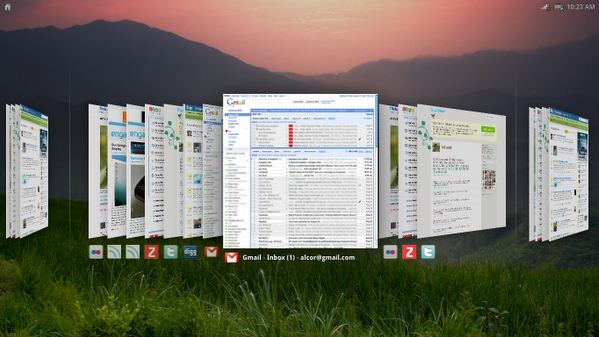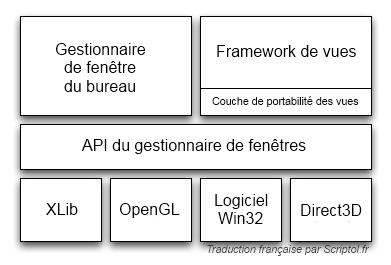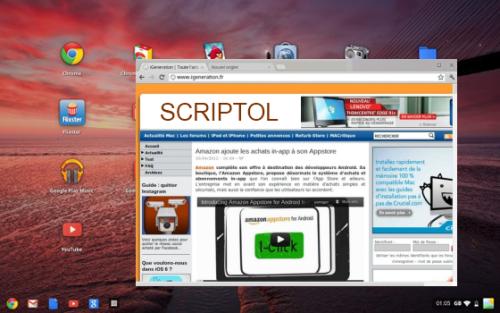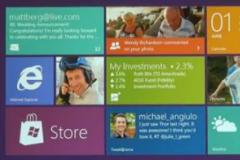Google Chrome OS
In the continuity of the Chrome browser, Google launched the Chrome OS project, an operating system that was originally designed for netbooks .
The first computers with this operating system, Chromebooks, have been available since June 15, 2011 .

Window management in Chrome OS
It can also be used on desktop PCs, but is mainly intended for Internet users.
Chrome is anti-OS (it seems to have evolved with Aura Manager), according to Eric Schmidt, CEO of Google. He does not hide the fact that the goal of the OS is to increase the audience on the Internet. Data is stored on the Web. The ideal user seems to be a Facebook or Google + client who puts their documents and photos in the cloud and does not want to know what a file system is.
It can start in seven seconds and is free. The system is powered by Intel or AMD x86 and ARM processors.
Chrome OS is a different system
Google wants to completely redesign operating systems. They are currently the source of problems for the user:
- Application installation time.
- Software upgrade.
- Need to save his data.
- Viruses.
- Compatibility with hardware and legacy software.
Chrome's design and use of web apps want to free the user from it all. To speed up the system, it is completely in memory, which excludes access to disks - the main source of slowdown.
Architecture
This is a Linux system with a graphical window user interface, a new design. It will be virus-resistant and easy to update.
Applications that will be developed in this environment along with classic web development tools should work on all browsers. It will also run on Windows, Linux and Mac.
Thanks to a system called chromoting, it will be able to run local applications in a browser on both one computer and a remote computer.

Characteristics
The new OS is designed from scratch, as did the browser, whose interface we see differently and clean.
The system is focused on the following points: speed, simplicity and safety. It's designed to be lightweight, which also gives it execution speed.
This also applies to the browser. It provides virus protection, including by using a specific runtime environment. The same goes for the OS, each application is encapsulated .
The graphical interface will be minimal, applications will work in a web browser, which will make them work on other operating systems.
The desktop will consist of tabs, one per application and only web applications will work.
Aura's manager

This window manager in Chrome OS is what Metro is in Windows 8, an interface that makes the system simple and enjoyable to use. But it looks more like a classic desktop with an icon bar at the bottom for apps like Gmail, and a set of indicators on the right.
Applications are represented by icons on the desktop with wallpapers. In fact, it's surprising that Windows 8 has a tablet interface, and Chrome OS, designed for lightweight laptops, uses a desktop interface.
The difference from the classic OS is that Notepad (here called Scratchpad) saves your files to Google Docs, and we are not in the local file system. The same goes for your Picasa-processed images. It makes life easier through privacy, but great for companies and schools or for reusing documents on a smartphone.
Read more about Aura in the Chromium wiki. They learn that Aura should work on Windows, and it is built on Gtk. On Linux, it will be able to fill in users who do not understand the direction taken in KDE 4 or Gnome 3 .
Cloud printing
Unable to provide drivers for all types of printers available on the market, Google came up with a solution to allow web applications to print documents: manage server printing.
Since the document is already available on the server with the online application, printing is managed by the server, so regardless of the user's equipment, it simply sends the appropriate content and printing instructions to the printer.
New printers will have to account for the cloud and be connected directly to the network to receive documents for printing. For current printers, special software will be provided to connect them.
In any case, communication with the network can go through a computer and a USB port.
Chrome OS and other systems
Chrome OS competes with Intel's Moblin, also based on Linux, and Windows CE or Seven.
Android All
Android was designed for mobile phones and may possibly run on netbooks, but manufacturers consider it insufficient for the latter.
On the other hand, more and more mobile device manufacturers have adopted it.
Android is Java software, while Chrome OS is a Linux system with a minimal interface. Android has a touch interface that is suitable for mobile devices, desktops that require a keyboard and mouse. Therefore, the future merger of the two operating systems involves a single interface.
Windows All
Chrome OS is a way to offer an alternative to Windows .
Chrome is in constant development, and the new direction that designers want to take is the separation of the graphical interface, consisting of windows and a backend. The latter can be XLib, OpenGL or Win32 and DirectX, that is, Linux or Windows...
That is, a universal interface that works on any computer.
V. Linux
Chrome OS is really just a Linux-based browser, it doesn't need a special OS, there are alternatives like KDE Plasma, or Firefox OS, which have the advantage of promoting standard APIs for programming components. So if your access account is disabled, or you no longer want to pay for online storage that is no longer free after two years, you can still install Linux.
But in 2018, ChromeOS expanded with the ability to include Linux tools in a virtual machine, in a separate environment, as well as development tools like CLang, as well as using the IDE as KDevelop.
What is the future of Chrome OS
?Smartphones and tablets are designed to take a large market share from computers and especially netbooks. But the latter is the best performance tool, by the way, it replaced Apple tablets in schools .
In the professional market, the system is provided by subscription and uses a terminal. It competes with Microsoft's equivalent-price offer. It also competes with Linux, which can provide the same service paired with a browser. Even more since he got the opportunity to work honestly with Linux tools in 2018.
In January 2013, Samsung's Chromebook became the best-selling laptop on Amazon US, selling for $249. In February 2013, HP announced the first Chromebook with a 14-inch screen (for $330), so it is closer to a laptop than to a notebook.
2013 was the year of ChromeOS. The percentage of Chromebooks sales in the United States among all computers and tablets increased from 1% in 2012 to 10% in 2013, as well as to 21% of notebooks (laptops with a reduced screen). This worries Microsoft, especially since 20% fewer notebooks were sold under Windows! Out of habit, when she feels threatened by Google, the firm has released a video to devalue Chromebooks on its Scroogled site.
What they said...
Comments by IT players.
Bill Gates (co-founder of Microsoft):
"The blurrier they are and the more interesting it sounds." (Ref).
Eric Schmidt (former head of Google )
"It tells us when people are spending more time online. So for us, this is an initiative whose strategy is really important, which will lead to an increase in our revenues."
See also
Further information
